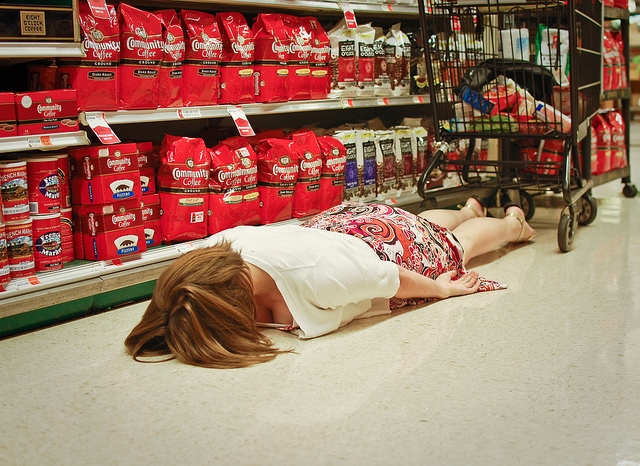
It’s big, it’s bright…and it’s usually really cold too.
The grocery store can be an overwhelming place. Sometimes a well-intentioned trip to the supermarket can end in feelings of guilt and negativity.
My first few “adult” years visits to the grocery store were often unplanned and overpriced. I spent most of my money on pre-packaged meals and got sucked into junk food snacks. I was a 22-year-old buying Gushers and Cinnamon Toast Crunch. I had this unconscious mindset: since I looked healthy on the outside, I could eat whatever foods I wanted…in semi-moderation. There were many holes in this way of thinking that I’m only starting to understand now.
I had a history of iron-deficiency anemia dating back to high school. I had always been active and exercised regularly, but I wasn’t nourishing myself with real food. For the first time in my life, I started wondering if a 100-calorie pack of fruit snacks should really be equivalent to 100 calories of fresh berries.
I played around with cooking more from scratch and noticed how much better my body felt when I ate nourishing foods. I learned more about animal agriculture and the effect eating animals has on our bodies. The more plant-based foods I ate, the better I felt, both mentally and physically.
This period changed everything. Based on my experience, I’ll walk you through my well-practiced methods for healthy, affordable and painless grocery shopping:
Make a Meal Plan.
Now that you’ve decided on your meals, make your list. Never go to the store without a list.
You’ve heard this before, right? But somewhere between the kitchen and the grocery store doors, you misplaced your list (or forgot to make it while rushing to the store after work!) and now you’re wandering the isles with a faint memory of the contents of your pantry or fridge. Insert cravings, impatience, and bad decisions.
Fear not, my friends! You may consider crossing over to a mobile list app or making your list in the notes app on your phone. This was a game changer for me. There are a lot of free list apps out there so browse around and find what works for you! Having a list on your phone allows you to add items at any time and, unless you forget your phone, you’ll never be at the store without a list.
So, you’ve made it to the store, you have your list, now you need a strategy.
• Stick to the list. Avoid impulse purchases like soda, snacks, candy, or bakery goods.
• Spend most of your time in the produce section. Choose fresh ingredients. Avoid pre-packaged meals and snacks, these will seriously impact your budget and are usually packed with added salt and sugar.
• Shop seasonally. Be aware of what fruits and veggies are in season and what you can find locally. Avoid buying peaches in December or butternut squash in May. We will end up paying more and receiving food that, in most cases, has been shipped from across the globe. It won’t taste great or be as nutrient-dense.
• Just drink water. Avoid buying soda, teas, and juices. Even when they seem healthy, they often still contain way more sugar than you need. And they are pricey. Get a water filter and a reusable water bottle. If you need some flavor, try adding fresh fruit or veggies. Cucumber-mint water is my favorite. And choose smoothies over juices. We need the extra fiber (juices remove most of the fiber through filtering (i.e. no pulp) to slow down the absorption of sugar when we take in fruits and veggies.)
Buy in Bulk.
Not muscle bulk. Buy in bulk! Grains, nuts, and seeds are ideal to purchase in bulk. This ensures you get the best price and that you always have those staple items on hand.
My go-to bulk buys:
• Almonds
• Cashews
• Walnuts
• Pepitas/Pumpkin Seeds
• Sunflower Seeds
• Lentils
• Brown Rice
• Quinoa
• Granola
• Rolled Oats
• Beans
In the winter months, I also buy more canned items in bulk, like diced tomatoes and some canned beans. The key is to look for “no salt added” or “low-sodium.” This may mean it has a slightly shorter shelf-life, but it’s saving you from adding tons of unnecessary salt to your meals.
Most grocery stores have bulk sections these days, so feel free to shop around. Just make sure the quality and price are up to your standards! Choose raw nuts and always check out the sugar content when you’re buying packaged granola or oatmeal.
Snack before you Shop.
This category is two-fold. First, snack before you shop, friends! Grab a granola bar or piece of fruit, take your water bottle, and don’t let your hangry brain take over. You will make better choices and that guy in front of you walking at snail-speed won’t make you want to scream… well, I can’t guarantee that last part. Work on your anger, dude. Serenity now.
Secondly, don’t forget to consider snacks when you shop. It’s easy to think about breakfast, lunch, and dinner, but if we don’t account for snacks, we’re more likely to choose a fast option and that’s usually not the healthy one. Making the aforementioned granola bars on a Sunday afternoon is a great option for snacking throughout the week. We shouldnt forget fresh fruit (apples and oranges travel well, berries are lovely if you throw them in some tupperware first) or veggies (chopped carrots, sliced cucumber, cherry tomatoes, and broccoli make for good snacking too). Be aware of your own cravings. Do you go for something salty or sweet? Find a healthier option that won’t leave you wanting more. Stay away from 100 calorie packs or “low fat” snacks, they are typically low in nutrients as well as calories and will just leave you hungry and sad. Eat real food.
Bring your own bag.
Be a grown up and bring your reusable bag. No one wants 1,493 840 plastic bags clogging up space in a house, car, landfill or in the ocean. Everyone suffers.
Plus, reusable bags are more durable and they come in fun designs. Buy a few, use them, don’t make a big deal about it!
Another important part of limiting waste is working hard to make sure you go through your groceries. Don’t buy one gallon of strawberries at Costco if you’re only feeding two people (unless you plan to freeze them). Those berries will start to mold as soon as you get home and you will be red in the face from eating so many. We’re talking a “Scarlett’s turning Scarlett!” situation here. But really, lets not justify buying perishables in bulk if we know we can’t go through them. It’s not worth the money and it’s not worth the waste.
Also, consider saving your veggie scraps to make homemade broth. It’s super yummy and doesn’t require any extra veggie purchases. When cooking and chopping veggies, save the ends of onions and celery, the stems and seeds of bell peppers, extra garlic cloves, or fresh herbs that are about to go bad, add them to a gallon freezer bag, keep adding to it until full, then boil with nine cups of water, one tsp salt, two bay leaves, strain out your veggie scraps, and voilà—tasty, homemade broth. Use it within a week or freeze it for a few months.
I hope these words will make you prepared for the next grocery trip!
Author: Alyssa Zimmerman
Image: Britt-knee / Flickr & Author’s Own
Editor: Sara Kärpänen






Read 0 comments and reply